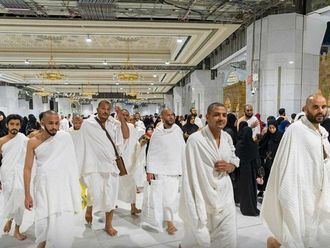
New Delhi: Malls are open. Restaurants are packed. Markets are buzzing. As coronavirus cases plummet to their lowest levels in months, India’s lockdown feels increasingly like a thing of the past.
But 18 months after the country’s primary school students were sent home in March 2020, tens of millions remain out of school.
In the United States, students began returning to school in August, even as the delta variant surge in parts of the country delayed openings. In India, schools for older children have gradually reopened in recent months, but primary schools in more than half a dozen states have not. In major cities such as Mumbai and Delhi, at one point the country’s coronavirus hot spots, they remain closed.
Education professionals warn that the break in education threatens decades of progress in raising literacy rates.
The 2011 census, India’s most recent, recorded the national literacy rate at more than 73 per cent, a jump of more than 20 percentage points from two decades before. The rate was higher among younger adults, a signal of the success of government efforts to provide universal free education. A yawning gap between male and female literacy, too, had narrowed.
Marginalised communities
But recent studies paint a grim picture of the impact of the extended school closures. Students from rural areas, where a majority of the country’s population resides, and those from marginalised communities, faced multiple barriers to continuing their education even before the pandemic.
A survey in August spanning 15 states found that 37 per cent of children in grades one through eight in rural areas were not studying at all, and nearly 50 per cent could not read more than a few words. Results in urban areas were only marginally better. The survey of nearly 1,400 children focused on students from underprivileged backgrounds who studied in public schools.
Reetika Khera, a professor of economics at the Indian Institute of Technology in Delhi who helped oversee the survey, worries that the scale of the problem isn’t widely understood. “These numbers suggest that an entire generation faces the real risk of remaining illiterate,” she said. “Whether the risk materialises depends on whether we wake up and take remedial measures.”
Particular difficulty
The survey detailed many of the challenges confronting children. A lack of smartphones and problems with connectivity plagued many households. In several instances, schools or teachers were remiss in sharing study material online. Young children whose parents hadn’t completed their own educations faced particular difficulty in understanding online classes. Other studies produced similar worrying findings.
The lockdown last year snatched Jagdev Bhuiyan’s livelihood. Now, it imperils the future of his children.
Bhuiyan, 32, works as a daily wage labourer in central India. He said his son in grade four and daughter in grade two have barely studied over the past year and a half. The family has one smartphone, and poor connectivity hampered their ability to access online classes.
Initially, the children sat with their books and attempted to study, but with no monitoring, they soon lost interest. They spend their days now playing outside with other village kids. The discipline inculcated by the rhythms of daily school life has evaporated.
“They have zero knowledge now. They don’t remember anything,” Bhuiyan said. “I don’t know how they will cope.”
Catching up
India isn’t the only country where young children remain out of school. Schools throughout the Philippines have been closed since the start of the pandemic. The government in September gave approval for 120 schools to resume classes in a pilot reopening. In Venezuela, online classes continued this month; some teachers have set up informal classes.
Education professionals warn that children who find it difficult to catch up when classes resume are at risk of dropping out.
Jean Drze, a development economist who helped conduct the 15-state survey, said a preliminary comparison of figures from the last census and the survey reveals an alarming trend.
The average literacy rate in India for rural children aged 8 to 12 in 2011 was 88 per cent. In the survey, it was 53 per cent.
Differences in literacy criteria used by the census and survey are unlikely to explain this massive gap, Drze said.
“Millions of children in India are in danger of being effectively left out of elementary education from now on, even if they are nominally enrolled in school,” he said. “This would condemn most of them to a life of hard labor and powerlessness.”
Some analysts believe the learning losses can be reversed. Krishna Kumar, an academic, told Frontline magazine that the decline in children’s capacities is not surprising. “We must remember that a capacity once acquired will resurface and gradually gain strength,” he said.
But activists warn of a rise in child labour as families in continued economic distress reach a breaking point. In some parts of the country, school girls are being married off. The decision to reopen schools has been left to the state governments, many of whom have been hesitant to take on the risk over worries that a new coronavirus wave could impact children.
Epidemiologists here have called on the government to resume in-person classes, saying the risk of young children contracting the disease remains low.
Some state governments have attempted to stem the mounting learning losses with local initiatives. In Odisha, a poor state on the eastern coast of the country, a government initiative supported by UNICEF connected trainee teachers with out-of-school kids in villages.
One of them was Jagadish Harijan, 25, in the first year of his training course. Harijan said he began offering basic reading and writing classes in July to 10 students and the number soon swelled to 40.
'One letter every day'
In one of the first classes, he was stunned to see a 7-year-old had forgotten the letters of the local Odia language he was schooled in. “I group them based on their abilities, not their class,” said Harijan. “I started slowly, by teaching to read and write one [letter] every day.”
The older ones began to catch up fast, he said. But some of the younger ones had never been inside a classroom before. Harijan worried that they will be promoted to the next class without the requisite knowledge.
In Maharashtra, a large state in western India, the government this year launched special courses to help students review the previous year’s syllabus before they can be promoted to the next class.
But education professionals fear that piecemeal efforts might not be enough.
The “unprecedented education crisis” needs “greater investment,” said Yasmin Ali Haque, UNICEF’s India representative. The government needs to provide tools and facilities for remote learning, she said, in addition to training teachers and opening schools safely.
“The time for India to act is now,” Haque said.
Even where schools have reopened, parents remain worried. Nazia Parveen, 30, the wife of a daily wage worker in the state of Bihar, was a proud mother. Just before the pandemic hit, her daughter, Kashish, a student in grade one, ranked first in her class.
Parveen didn’t complete her education, but she hoped her daughter would attend college to get a white-collar job. When she saw Kashish slide backward during the lockdown, she borrowed money to send Kashish for private tutoring. Now, school has resumed and she hopes Kashish will be able to make up for the time she lost.
“I understand the value of education,” Parveen said. “I want [her] to study and grow in life but the future seems uncertain.”








